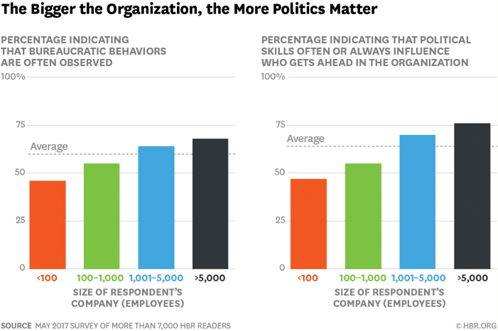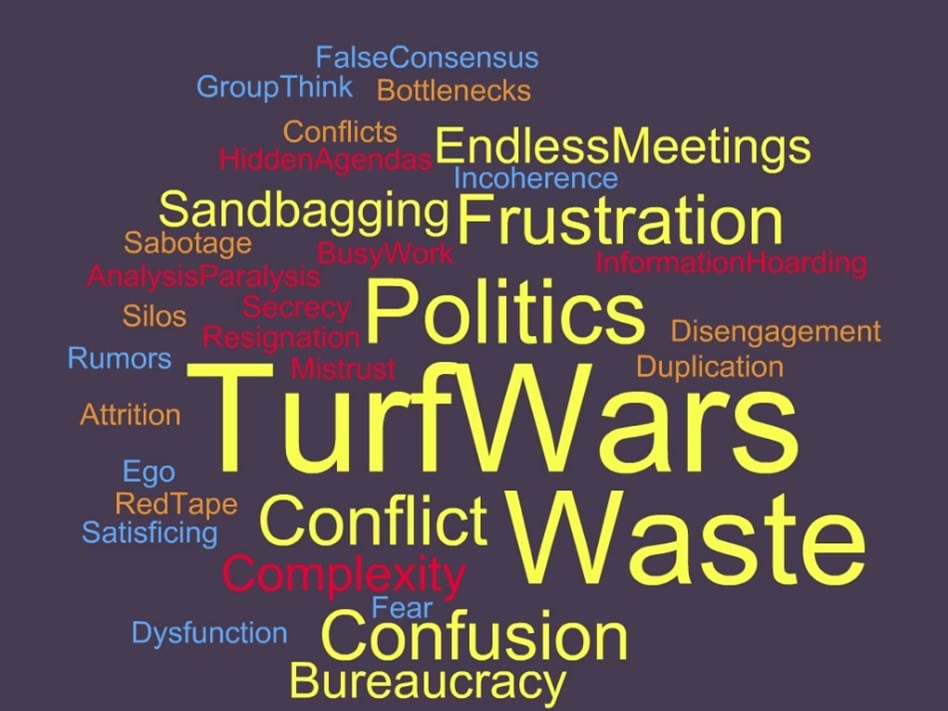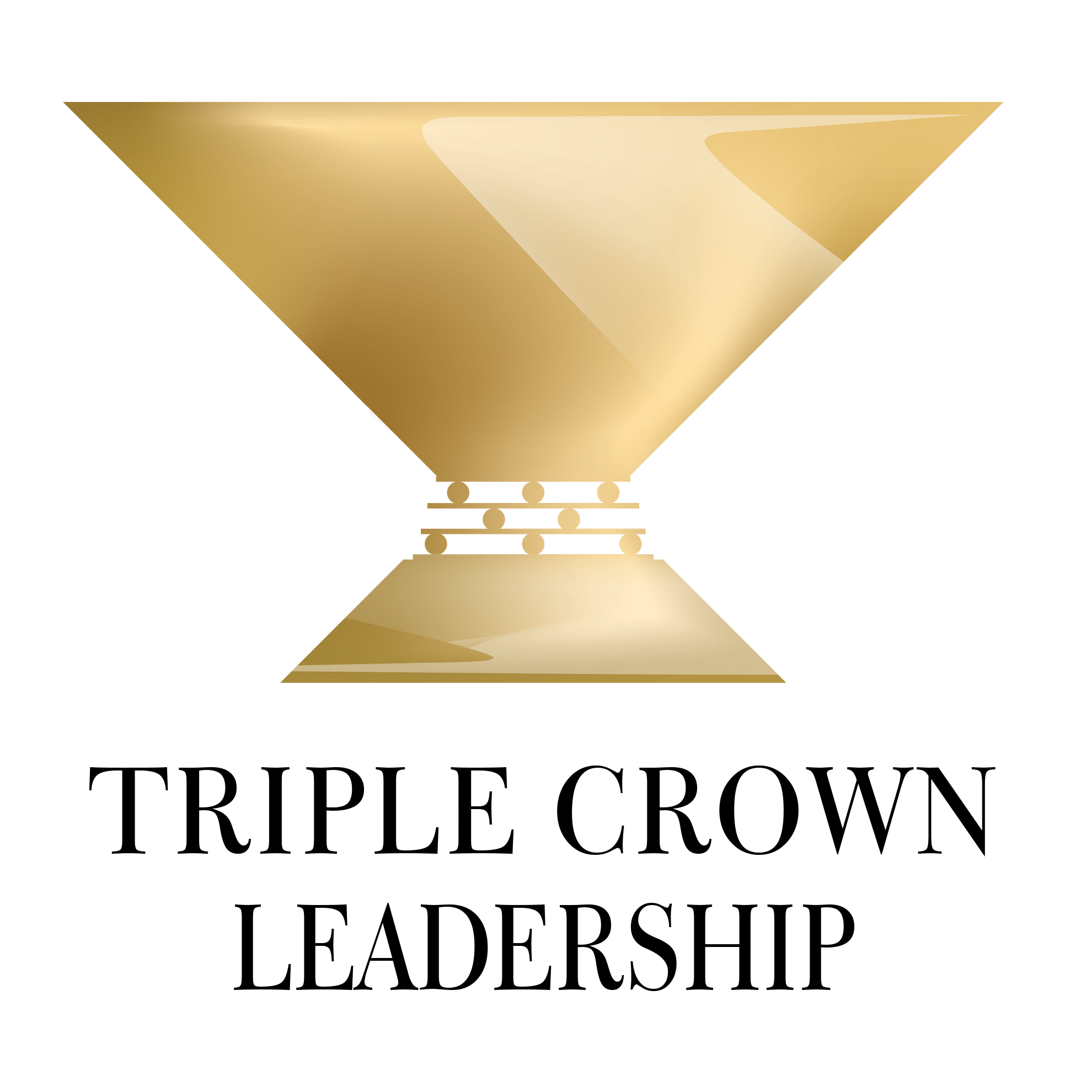Article Summary:
Factions and office politics are common in organizations. Good leaders learn to bridge such factions and address the politics to help create unified and aligned organizations that excel.
+++
Factions are small, dissenting groups within larger groups. Many factions take a contentious approach, fueled by their self-serving agenda and narrow and stubborn view of the way things should be.
The idea of a faction is built into the founding of the United States, with heated debates about how to institute controls on government to avoid the kinds of tyranny and corruption the Colonists were fighting against. (1)
Factions in Organizations
Organizations have factions too—different groups with varying values and competing commitments. Companies, nonprofits, schools, hospitals, religious organizations, police and fire departments, and other groups all have factions sometimes. (We’re seeing it play out now in historic strikes among automakers and health care organizations.)
Once groups form in an organization, alliances form naturally among subgroups with common views or similar aims. People find comfort and companionship in joining with others who share their opinions or beliefs.
“…teams, because they are made up of imperfect human beings, are inherently dysfunctional.”
-Patrick Lencioni, The Five Dysfunctions of a Team

Leadership Derailers Assessment
Take this assessment to identify what’s inhibiting your leadership effectiveness. It will help you develop self-awareness and identify ways to improve your leadership.
Office Politics
In addition to factions, all organizations also have internal political dynamics. People use organizational power and authority to arrange outcomes that serve their own personal interests, including higher compensation or status. Politics and factions are inevitable in organizations.
According to research from Gary Hamel and Michele Zanini cited in Harvard Business Review, this problem tends to metastasize as the size of an organization increases. The bigger the company, they report, the more politics matter. The charts below show the percentage of workers in companies of different sizes saying, first, that bureaucratic behaviors are observed often and, second, that political skills often influence who gets ahead. Clearly, those numbers increases dramatically with size.

“… the question is not whether organizations will have politics
but rather what kind of politics they will have.”
-Lee Bolman and Terrence Deal, Reframing Organizations
Many of us have encountered political behaviors in the workplace, including scheming, sandbagging, infighting, turf-protecting, gatekeeping, self-promoting, sucking up, and even sabotaging others. Those behaviors damage organizations, since they lead to stress, frustration, mistrust, disengagement, dysfunction, and attrition.

The Problem of Division
Factions divide people. Some factions might not align with an organization’s shared purpose or values. Subcultures can form that damage the organization’s culture, in some cases creating toxic micro-cultures. Though people are supposedly on the same team, they can act as though they’re mortal enemies. Essentially, colleagues become like cats fighting dogs. It ain’t pretty.

Gregg experienced this firsthand at a social enterprise he worked for years ago. For starters, there was a conflict between the sales team and the operations and management department, with the former promising customers all sorts of things that the company couldn’t yet deliver, in part because of their aggressive sales targets and compensation incentives. Next, a cultural rift developed between the people who were driven by the excitement and rewards of company growth and a possible lucrative exit and the people who were more driven by the possibility of customer transformation and social impact. Eventually, people were playing games like stealing talent away from other departments for their own gain instead of focusing on collective priorities and shared interests. It was ugly.
“The ultimate dysfunction of a team is the tendency of members to care about
something other than the collective goals of the group.”
-Patrick Lencioni, The Five Dysfunctions of a Team
Unfortunately, this is all too common. For example, salespeople might gang up on the product development team for the glacial pace of new product releases. Everybody’s mad at Finance or Legal. HR and IT battle over scarce resources. Nonprofit fundraisers have conflicts with the financial team. Firefighters decry the lack of funding for training or new equipment from their city councils.
Infighting among factions can damage the organization’s credibility in the eyes of outside stakeholders. Customers become disenchanted, citizens feel shortchanged, and donors vote with their feet, taking their contributions elsewhere.
If “culture is the legacy of leadership,” as we wrote in Triple Crown Leadership: Building Excellent, Ethical, and Enduring Organizations, then disgruntled factions can poison a culture. So, leaders must pay attention to any factions that imperil the achievement of their mission.
Good leaders bridge factions.
How Good Leaders Bridge Factions
Good leaders don’t let factions duke it out. That’s avoidance.
“…if you don’t do politics, politics will do you.”
-Niven Postma, leadership facilitator and expert on organizational politics
Good leaders connect people. They create mutual respect and what Stephen M. R. Covey calls “smart trust.”
How can leaders bridge factions? Here are some recommendations based on our experience:
Good leaders recruit, develop, and reward both “head and heart” in the organization. (“Head” aspects are things like knowledge, skills, and technical competence, while “heart” aspects are things like integrity, courage, authenticity, and resilience.) People with heart will be more likely to bridge factions—and be good at it.
Good leaders collaboratively elicit a shared purpose, values, and vision from the team and then weave those into the fabric of the organization. We call them the “colors” of the organization. It’s essential to communicate them often and work them into people’s everyday experience via meetings, check-ins, performance reviews, incentives, messages, reminders, and more.
Good leaders encourage people to get to know one another personally, forming relationships of trust and mutual respect. People who don’t know one another can’t trust one another. Personal time together, especially in this age of remote work, is essential. People should learn each other’s backgrounds, what crucibles they’ve endured, and how they developed their views and beliefs.
Good leaders urge people to listen deeply to other people to understand their points of view. Too many of us are working on formulating our replies when having a conversation with others instead of truly listening to what they’re saying.
Good leaders encourage people to have an open mind. It’s fine to have and express our opinions, but it’s important to be open to new ideas and different perspectives. (See our article, “The Power of Dialogue for Leaders and Groups.”)
Good leaders urge people to find common ground. Even people with widely differing opinions or worldviews can find points of agreement. For example, we all want clean air and water, safe schools, and financial security. At work, we all want respect, autonomy, fairness, and opportunity.
Good leaders encourage people to move forward on areas of agreement even if they can’t agree on everything.
Good leaders encourage people to compromise—not on core beliefs and principles but on preferences that are more loosely held. Back in Kindergarten, we should have learned that we can’t always get our way on everything. Welcome to the real world.
“You can’t always get what you want,
but if you try sometimes, you just might find you get what you need.”
-The Rolling Stones
Good leaders align their organizations. (See our article, “How to Align Your Organization for Peak Performance,” with our ten-step alignment model.) Alignment is a collaborative process providing cohesion, clarity, and focus to get everyone moving in the same direction. It also helps people get to common agreements and focus on the whole organization instead of their parochial interests and factions.

Alignment Scorecard
When organizations aren’t aligned, it can reduce performance dramatically and cause frustration and dysfunction. With this Alignment Scorecard, you can assess your organization’s level of alignment and make plans for improving it.
Good leaders reach out regularly to people, groups, and stakeholders to understand their perspectives and priorities. They listen and build relationships and mutual respect.
Conclusion
Factions and office politics can be painful. But that doesn’t mean that leaders should avoid dealing with them, putting their head in the sand. Too often, a fear of conflict prevents needed action, so the organization remains stuck, and people get increasingly frustrated—and leave.
Bridging factions and addressing office politics can’t be handled with a one-time intervention. It takes time and patience, and it’s essential to building a high-performance culture.
Good leaders bridge factions.
Reflection Questions
- Does your organization have factions and office politics that are causing major problems?
- Are you ready to address them?
- What will you do, starting today?
Tools for You
- Leadership Derailers Assessment to help you identify what’s inhibiting your leadership effectiveness
- Personal Values Exercise to help you determine and clarify what’s most important to you
- Alignment Scorecard to help you assess your organization’s level of alignment

Personal Values Exercise
Complete this exercise to identify your personal values. It will help you develop self-awareness, including clarity about what’s most important to you in life and work, and serve as a safe harbor for you to return to when things are tough.
Related Articles
- “The Dangers of Toxic Micro-Cultures”
- “Why Conflict Is Good—And How to Manage It”
- “The Power of Dialogue for Leaders and Groups”
- “Synthesis: A Critical Leadership Skill”
- “Communicating with Steel or Velvet”
- “How Leaders Can Become Better Listeners”
Appendix: Adaptive Leadership and Factions
Besides the Alignment Model in our triple crown leadership framework, another relevant framework is Harvard Professor Ron Heifetz’s “adaptive leadership” model. In this model, Heifetz says that leaders must distinguish between technical and adaptive challenges.
Technical challenges have a clear problem definition (e.g., an accounting firm’s frustrations with its software programs), and an expert or manager can provide the solution (e.g., a manager contacts the provider and has the programs modified). With an adaptive challenge, by contrast, the problem definition and solution are unclear. The situation requires new learning and a change in priorities, beliefs, roles, or values. An example includes different departments with conflicting perspectives and goals, causing confusion and chaos.
In adaptive circumstances, people (including leaders) use “avoidance mechanisms” so they don’t have to change. Avoidance behaviors include things like ignoring the problem, blaming management (or coworkers, or the board), attacking others, or working hard on things unrelated to the core issues.
According to Heifetz, leaders must maintain disciplined attention on the key issues and mobilize people to face, not avoid, the tough realities and conflicts. He notes that the question isn’t how to avoid conflict and eliminate change; rather, it’s how to manage conflict and produce positive change.
“Adaptive work consists of the learning required to address conflicts in the values people hold, or to diminish the gap between the values people stand for and the reality they face. Adaptive work requires a change in values, beliefs, or behavior…. The inclusion of competing value perspectives may be essential to adaptive success.”
-Ronald Heifetz, Leadership without Easy Answers
Postscript: Quotations on Factions
- “By a faction, I understand a number of citizens, whether amounting to a majority or a minority of the whole, who are united and actuated by some common impulse of passion, or of interest…. The latent causes of faction are sown in the nature of man.” -James Madison, Founding Father and 4th U.S. president
- “United we stand, divided we fall. Let us not split into factions which must destroy that union upon which our existence hangs.” -Patrick Henry, Founding Father and former Virginia Governor
(1) The American Founders realized that, given human nature and the corrupting influence of power, they needed to be vigilant about controlling government and its associated factions. So, they designed checks and balances and a federalist system that distributed power among different levels of government. Essentially, they were admitting that they couldn’t get rid of factions. Instead, they’d pit faction against faction to ensure that nobody could acquire too much power. Such a separation of powers would slow things down and force people from different places, perspectives, and backgrounds to work with each other.

Triple Crown Leadership Newsletter
Join our community. Sign up now and get our monthly inspirations (new articles, announcements, opportunities, resources, and more). Welcome!
+++++++++++++++++++++++
Gregg Vanourek and Bob Vanourek are leadership practitioners, teachers, and award-winning authors (and son and father). They are co-authors of Triple Crown Leadership: Building Excellent, Ethical, and Enduring Organizations, a winner of the International Book Awards. Check out their Leadership Derailers Assessment or get their monthly newsletter. If you found value in this, please forward it to a friend. Every little bit helps!



1 thought on “How Good Leaders Handle Factions and Office Politics”
VERY GOOD IDEAS